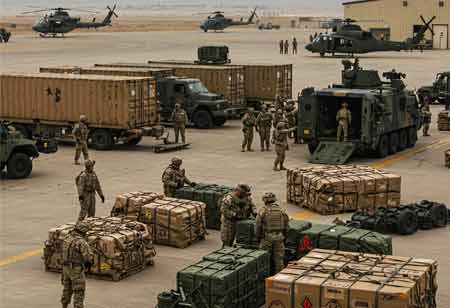Fremont, CA: Logistics has always been the essential backbone of any successful military mission, ensuring that troops arrive, are adequately supplied, and are strategically positioned when and where they are needed. As military strategies evolve and international threats become more complex, logistics must advance in scaling, precision, and agility.
Advancements in technology are transforming all aspects of military logistics in Europe, enabling faster decision-making, optimised resource allocation, and real-time adaptability. These powerful logistics movements are not merely responses to modern challenges; they represent a strategic leap towards a more intelligent, integrated, and resilient logistical framework.
Smart Automation and Predictive Systems
Automation has become the foundation of next-generation military logistics. Autonomous vehicles, drones, and robotic systems are employed to ferry supplies, perform reconnaissance, and conduct inventory; these approaches engage minimum human intervention. This minimisation gives greater operational efficiencies against putting people at risk, particularly in high-risk or contested domains.
Central to civilisational changes is AI, which seeks to convert logistics into predictive science. Using a very advanced algorithm, AI analyses a large amount of data, from weather forecasts to supply chain disruption, to predict future logistical needs. This permits commanders to anticipate demand and allocate resources, thereby better minimising waste. Machine learning systems will evolve using historical information to adjust supply routes and schedules to past performance and dynamic battlefield conditions.
Enhanced Supply Chain Visibility and Communication
Visibility and communication are lifelines for any logistical network, but they easily become strategic in military settings. Assets ascertainment, from ammunition to med-kits, is ensured over every supply chain link by leveraging blockchain technology, encrypted communication systems, and GPS satellite tracking. This level of transparency curtails losses, increases functioning accuracy, and provides an account.
Sensors are placed inside shipping containers and vehicles, sending temperature, humidity, and location information while transporting sensitive materials. IoT-enabled solutions detect deviations and trigger alerts to take swift remedial action. Centralised logistics platform digital dashboards provide supply chain health data, deployment time frames, humanitarian mission coordination, and combat readiness.
Sustainability and Resilience in Future Operations
Modern European military logistics must meet the mounting demand for sustainability and energy efficiency. Green technologies such as hybrid vehicles, portable solar units, and bio-based fuels lower the environmental burden by minimising reliance on weak supply routes. This becomes critical in remote or contested environments, where traditional resupply missions are often risky and resource-heavy.
Additive manufacturing, or 3D printing, is another game-changer in field logistics. From being the ultimate delivery solution, it now enables the troops to produce as-needed spare parts, tools, and even medical equipment on-site, thereby diminishing the need for giant stockpiling and long waiting times.
Resilience in logistics means flexibility. Modular systems and mobile supply bases allow forces to rapidly shift operations without interrupting the flow of supplies. This innovation builds a more flexible, self-sustaining logistical infrastructure by confronting climate, cyber, and geopolitical threats to the classical logistic scheme.









